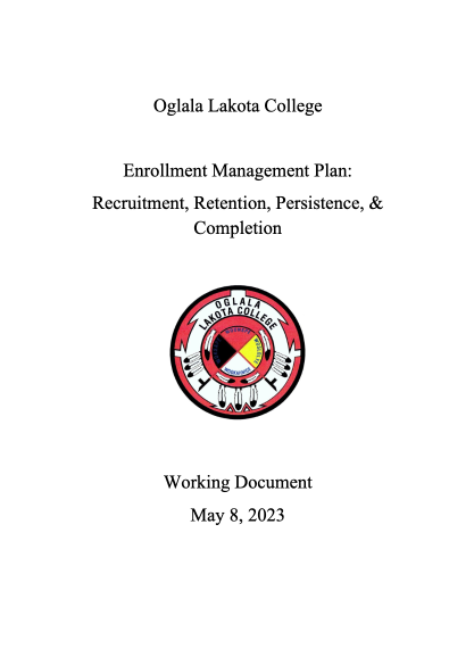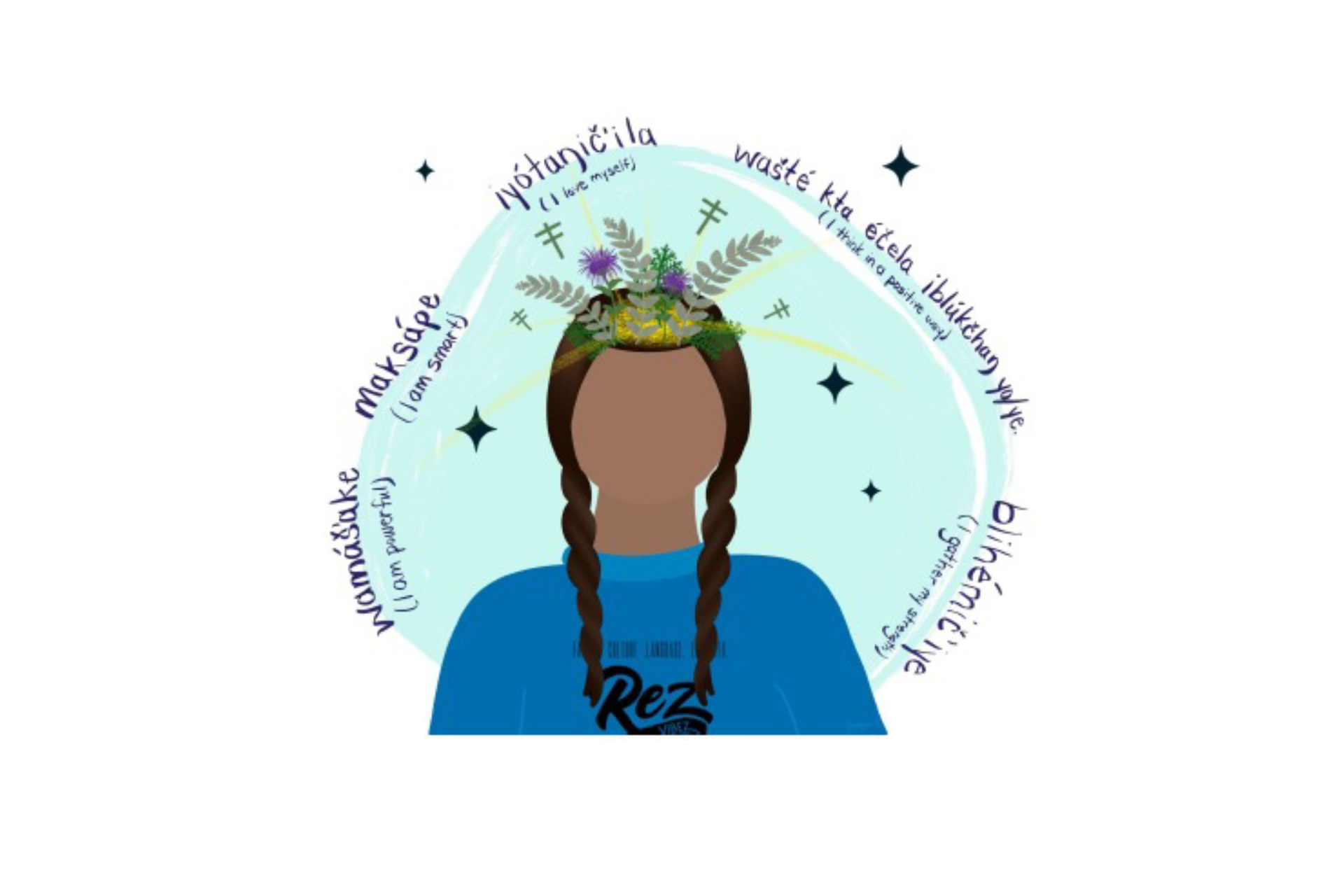
Oglala Lakota College
Strategic Enrollment Management
Throughout the restructuring process, new ideas and opportunities presented themselves and we were able to create a correlation between those new activities and ideas and the initial purpose of the CNSS grant.

Oglala Lakota Strategic Enrollment (SEM) Plan
Oglala Lakota College (OLC) has a history of promoting diversification of committee membership. For example, general education outcome assessment used to be conducted within the departments, OLC started to use interdepartmental scoring groups in 2014. Similarly, the Cultivating Native Student Success (CNSS) project team and the Student Success Committee includes representatives from various college units and roles. The CNSS team consists of the Enrollment Management Director (team lead), the Director of Institutional Research and Assessment, an academic chairperson, an academic counselor, and the Wellness Coordinator. A faculty member, the Student Affairs Coordinator, and the Registrar participated in the project in the past. Additionally, the Vice President of Instruction and the College President are included.

View the SEM Plan

“In 2021, the Office of Institutional Research and Assessment started to look into a possible connection between a student’s GPA in one semester and persistence to the next semester. A pattern became easily visible: The lower the GPA, the lower the chance that the student will return. The best way to increase persistence is therefore to ensure students earn good grades.”
OLC identified enrollment baseline data and performance targets at the beginning of the CNSS project. In comparison with the baseline, OLC only met one of the four targets: first-year retention of full-time, bachelor’s degree seeking students had increased from 56% from Fall 2018 to Fall 2019 to 66% from Fall 2021 to Fall 2022. OLC’s enrollment and the full-time first-time retention of associate degree-seeking students decreased in comparison with the baseline. The Spring-to-Fall and Fall-to-Spring persistence increased since the project started, but not as targeted.
REBUILDING THE LAKOTA NATION THROUGH EDUCATION
LAKOTA OYATE KIN WOUNSPE TANTANHAN UN TOKATA ETKIYA IGLOAPI KTE
OLC SEM COMITTEE MEMBERS
- President
- Vice President of Instruction
- Enrollment Management Director
- Foundational Studies Department Chair
- Academic Counselor
- Social Work Faculty
- Director of Institutional Research and Assessment
- Wellness Coordinators
Strategic Enrollment Management Dashboard
Key Indicator |
Baseline |
Performance Target |
Y1: 2020-2021 |
Y2: 2021-2022 |
Y3: 2022-2023 |
| Student Enrollment |  1306 Students Fall 2019 |
 1386 Students by Fall 2022 |
 1251 Students Fall 2020 |
1451 Students Fall 2021 |
1177 Students Fall 2022 |
| Fall-to-Winter Student Persistence |
Fall 2019 to Spring 2020 |
Spring 2023 |
Fall 2020 to Spring 2021 |
Fall 2021 to Spring 2022 |
Fall 2022 to Spring 2023 |
| Spring-to-Fall Student Persistence |
Fall 2019 to Spring 2020 |
by Fall 2022 |
Spring 2020 to Fall 2020 |
Fall 2021 to Spring 2021 |
Spring 2022 to Fall 2022 |
| First Year Student Retention FTFT Bachelor’s |
Fall 2018 to Fall 2019 |
by Fall 2022 |
Fall 2019 to Fall 2020 |
Fall 2020 to Fall 2021 |
Fall 2021 to Fall 2022 |
| First Year Student Retention FTFT Associate |
Fall 2018 to Fall 2019 |
by Fall 2022 |
Fall 2019 to Fall 2020 |
Fall 2020 to Fall 2021 |
Fall 2021 to Fall 2022 Cohort |
| Student Completion FT Bachelor’s GR150 |
Fall 2014 Cohort by Summer 2020 |
Fall 2022 Cohort by Summer 2028 |
Fall 2015 Cohort by Summer 2021 |
Fall 2016 Cohort by Summer 2022 |
|
| Student Completion FT Associate GR150 |
Fall 2017 Cohort by Summer 2020 |
Fall 2022 Cohort by Summer 2015 |
Fall 2018 Cohort by Summer 2021 |
Fall 2019 Cohort by Summer 2022 |
OLC’s SEM planning encountered several challenges. The most impactful was that OLC (and the CNSS project team) was without a full-time Enrollment Management Director from July 2020 to December 2023. OLC emphasized the need to ensure that core enrollment management responsibilities were not neglected despite the vacancy. Between Fall 2021 and December 2023, the Foundational Studies Department Chair had the enrollment management position added to her duties, and the Student Affairs Coordinator was responsible for the alert system. Many OLC units have been short-staffed, requiring employees to take on additional responsibilities. As a result, long-term planning like SEM was pushed back. A different type of challenge has been students not following-through with attending co-curricular events such as orientations, study skills workshops, etc..
OLC is currently working with several internal departments and committees to plan and implement strategic enrollment strategies for the next four years. These include, but are not limited to:
- Conducting college wide virtual student check-in sessions at midterm to re-engage students and encourage persistence to attend classes and complete coursework. These sessions will focus on topics such as communication, self-advocacy, persistence, and empowerment, while also reminding students that OLC has many services to offer them and to aid them in their educational journey.
- Hiring a Retention Advisor to assist the Enrollment Management Director (EMD) with programs and services. It became apparent after not having an EMD for over two years and having to delegate the responsibilities that fall under the Enrollment Management Office (EMO), that further support staff would be needed to aid in organizing and completing tasks. With this position, the EMO will be more effective and responsive with respect to planning and implementing student services, recruitment, retention, persistence, and completion.
- Continuously updating the Strategic Enrollment Plan so that it actively reflects OLC’s mission and vision.
- Increasing cross-departmental and community collaborations to provide more effective and engaging student services, programming, and activities. By including the communities in which the college centers reside, we will be able to provide a bigger support group for students.
- Increasing the professional development opportunities for college center staff as they are the first point of contact for students. These professional development opportunities will include customer service training, leadership training, cultural sensitivity training, and will be conducted regularly to ensure staff competency.
- Continuation of faculty, staff, students, and program evaluations to gauge the effectiveness of services and programming and to allow for adjustments when they are needed. Evaluations of faculty and staff will provide us with further direction on professional development that is needed.
- Increase the number of recruitment activities within college center communities to build better rapport and support for students.
- Increase the number of area high schools that have Native student populations in OLC’s recruitment activities by networking and engaging the high schools in OLC conversations.
Data Was used to monitor if Student’s Basic technology needs were met, if students continued to attend class regularly. And if they successfully completed their courses despite adversity.
Best Practices
1
Utilizing an early alert system and providing frequent training on its use.
Learnings
- Early alerts play an integral role in retention at OLC. This system was first piloted in 2013 as a means to increase retention and persistence of students. Since its introduction, faculty, counselors, and enrollment staff have been able to intervene sooner when a student is facing attendance and/or grade issues that could result in the student dropping out. By issuing early alerts, OLC staff are able to collaborate and connect with students in an effort to ensure that they have the resources they need to be successful and to get back on track.
- One thing we learned during implementation and continuation of this program is that more frequent training needs to be offered to current and new staff who utilize it. A “Standard of Use” needs to be developed, as staff had differing ideas and understandings of how the early alert process works. Upon hire of a new Enrollment Management Director (EMD), a “Standard of Use” process was developed, and staff have been trained. The EMD will conduct this training on a semester basis to ensure current and new staff are consistent in their use of early alerts and how to process them.
OLC also came to realize that communication is a concern as students have proven to be unresponsive when issued an early alert. This is one of the reasons we created the Virtual Student Success Sessions and included communication as a topic that students needed to understand and develop.
Data/Evidence
Early Alerts Chart
Course Pass Rate by Early Alert Resolution Status

2
Mental Health and Wellness Services
Learnings
-
Prior to an in-house counseling service, faculty and staff have requested the mental health and wellness service for years. In its first year starting a new area of support services; the wellness services needed a framework, documentation, and policy to be established, publicized, serviced, and maintained. A wellness committee was established and documentation went through an approval process with the committee. With all the written components established with a proven need for mental health and wellness services, student individual counseling began within its first month of existence. The wellness services have continued to grow with each passing semester. The wellness services are for both students and staff members at OLC and services include individual counseling, group counseling, educational events and activities encompassing mental health information.
-
Learnings have come from the welcoming atmosphere of the OLC community to learn more about mental health topics, which relate to the continued growth and interest. OLC staff have expressed pride and trust in the institution of OLC for providing the much needed culturally appropriate wellness services. Improvement will develop as the wellness services mature.

“The pandemic caused an increase in workload for most employees, having to pivot to distance delivery of courses, managing new programs, such as the hotspot program, helping students succeed in the virtual classroom, additional data monitoring and reporting needed.”
Impact of Covid-19 Pandemic
The COVID-19 pandemic impacted Oglala Lakota College’s SEM planning. Many of the strategies were no longer feasible. For example, it was no longer possible to host in-person orientations, to travel to the local high schools for recruitment, or to host in-person focus groups as basis for revising OLC’s SEM plan. The pandemic also influenced OLC’s student success data. Some students enrolled because OLC remained almost 100% at distance through Summer 2022. Other students did not enroll because of the lack of in-person classes. The Coronavirus Aid, Relief, and Economic Security Act (CARES) funding was a major incentive for students to enroll. In Fall 2021, funding was widely announced, leading to an increase in enrollment followed by a lower course pass rate. Associate degree programs were impacted by the pandemic more than the bachelor’s programs. This is evident in the 150% (three year) completion rate of associate degree seeking cohorts, which dropped from 19% of students from the Fall 2017 cohort (completion by Summer 2020) to 0% of the Fall 2018 and Fall 2019 cohorts. A possibility is that several of the associate programs are hands-on, such as vocational education and nursing. These programs were less suited for distance course delivery.

“Despite all the hardships, the pandemic also had some positive impacts… OLC was forced to work on processes and ensure everything was available online (e.g., add and drop cards, application forms). One process that was moved online because of COVID-19 was the purchase of textbooks.”
The pandemic impacted the project team’s ability to work on the project. The pandemic was traumatic for everyone. Many experienced loved ones suffering from COVID-19, including many deaths, or suffered from severe impacts during and after the infection themselves. As a result, employees had little time and energy to work on the SEM plan. Despite all the hardships, the pandemic also had some positive impacts. Prior to the pandemic, many staff and faculty did not use Zoom, and there was hesitation moving in that direction. As a result, it became much easier to bring people together from various sections of OLC (i.e., the Student Success Committee, consisting of multiple center directors, counselors, and department chairs). Another positive impact of the pandemic was that OLC was forced to work on processes and ensure everything was available online (e.g., add and drop cards, application forms). One process that was moved online because of COVID-19 was the purchase of textbooks. In Summer 2021, OLC moved from books being transported to each of the eleven instructional sites by only two bookstore employees (requiring students to enter their center), to an online bookstore. Students ordered their books online and decided between having them shipped to their home or their “home” college center. This change caused challenges in Fall 2021 because students registered for classes late and therefore ordered their books late. Many Fall 2021 students were without textbooks for a substantial portion of the semester. In response to this issue and other problems with late admissions and registrations prompted OLC to revise its admissions and registration process.
